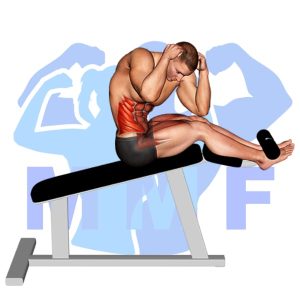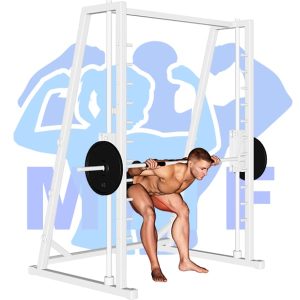Are you struggling with your side plank pose during your fitness routine? Don’t worry, you’re not alone! Many people find it challenging to hold their body up in a perfect alignment while in the side plank position, and this can leave you feeling frustrated and unmotivated. It’s a common problem, but it’s not one that you have to live with. With the right technique and a few helpful tips, you can perfect your side plank and take your fitness routine to the next level. In this blog post, we’ll provide you with all the guidance you need to conquer the side plank and feel confident in your abilities.
Side Plank Summary
- Primary Muscles: Obliques
- Secondary Muscles: Adductors, Hip, Gluteus Maximus, Gluteus Medius, Gluteus Minimus, Gracilis, Iliocastalis lumborum, Iliocastalis thoracis, Latissimus dorsi, Levator Scapulae, Pectineus, Pectoralis major, Pectoralis minor, Psoas major, Quadratus lumborum, and Tensor Fasciae Latae
- Equipment: Body Weight
- Mechanics Type: Isolated
- Force: Push
- Utility: Auxiliary

Side Plank Instructions
- Lie on your side on a mat or the floor.
- Place your forearm on the ground under your shoulder perpendicular to your body.
- Place your upper leg directly on your lower leg and straighten your knees and hips. Raise your body upward by straightening your waist, so your body is ridged.
- Hold this static position for 20 seconds to a minute per side.
Video Tutorial
Side Plank Muscles
Target (Agonist)
Synergists
- Adductors
- Hip
- Gluteus Maximus
- Gluteus Medius
- Gluteus Minimus
- Gracilis
- Iliocastalis lumborum
- Iliocastalis thoracis
- Latissimus dorsi
- Levator Scapulae
- Pectineus
- Pectoralis major
- Pectoralis minor
- Psoas major
- Quadratus lumborum
- Tensor Fasciae Latae
Dynamic Stabilizers
- None
Stabilizers
- Latissimus Dorsi
- Teres Major
- Pectoralis Major – Sternal
- Pectoralis Minor
- Rhomboids
- Levator Scapulae
- Trapezius – Lower
- Triceps – Long Head
- Brachialis
- Brachioradialis
- Biceps Brachii
Antagonist Stabilizers
- None

Benefits of Side Plank
Side Plank is an excellent exercise to include in any strength training or fitness routine. This exercise is great for targeting the obliques, which are the muscles on the sides of the abdomen. Additionally, Side Plank engages the core muscles and helps to strengthen the lower back and spine. It also improves posture and balance, making it an ideal exercise for increasing overall body stability. Furthermore, Side Plank can also help to improve core strength and endurance, making it a great choice for those looking to improve their overall fitness level.
Tips for Performing Side Plank
If you’re seeking to take your side plank to a new level, then you’re at the right place. Using these suggestions can allow you to take full advantage of this effective workout. You’ll have the ability to strengthen your obliques muscles, and reduce your chance of getting hurt. So let’s start now and see what these tips may accomplish for you.
- 1. Keep your core tight – When conducting the Side Plank exercise, make sure to keep your core tight and engaged throughout the entire movement. This will ensure you get the most out of the exercise and will help you to stay balanced and stable.
- 2. Keep your hips level – Keeping your hips level during the Side Plank exercise will help to target the obliques and core muscles more effectively. Doing so will also help you stay safe and avoid potential injury.
- 3. Focus on your breathing – Taking slow and deep breaths during the Side Plank exercise can help to increase the intensity of the workout and make it more effective. It will also help you stay focused and in control throughout the entire exercise.
Benefits and Tips Video
Frequent Mistakes To Avoid
When it comes to conducting side plank, avoiding typical errors is usually the difference between an effective workout and a debilitating injury. Additionally, in order to maximize your benefits of the exercise, proper technique is required. By avoiding frequent mistakes, you may improve your ability to achieve your desired results. Don’t worry, though, it’s not at all difficult as it may seem. You can execute the exercise safely and effectively by avoiding the mistakes to prevent and by following the correct steps. So it is time for you to maximize your results from this exercise and enjoy the benefits of a successful workout.
- 1. Not engaging the core: Many people forget to engage their core muscles when doing the Side Plank, which can lead to a weak and ineffective workout.
- 2. Placing the feet too wide: Having your feet too wide can cause you to lose balance and stability when doing the Side Plank, resulting in an ineffective workout.
- 3. Locking the elbow: Locking the elbow during a Side Plank will put too much strain on the joint, which can cause injury and pain if done repeatedly.
Find More Bodyweight Exercises Here
Variations and Complementary Exercises
The Side Plank exercise is a great way to work your core muscles, but it is not the only exercise you can do to target these muscles. For variety and to get the most out of your workout, consider adding some of the following variations, complementary, or alternative exercises to your routine.
Side Crunches

Side crunches are a great alternative or complementary exercise to the side plank. This exercise works the obliques, which helps to improve posture and strengthen the core. To do a side crunch, start by lying on your right side with your legs bent and feet flat on the floor. Place your hands behind your head and slowly lift your upper body off the floor, contracting your obliques. Then slowly lower your upper body back down to the floor. Repeat on the opposite side. This exercise can be done in sets of 10-15 reps for a more moderate intensity workout, or for a more intense workout, you can increase the reps to 20-30.
Side Bridge Hip Dip

The Side Bridge Hip Dip is a great complementary or alternative exercise for the Side Plank. This exercise helps to strengthen the gluteus medius muscle and the hip flexors, which are key muscles used in the Side Plank. To perform the exercise, you start by laying on your side with your legs straight and your top arm extended above your head. Then, while keeping your legs together, lower your hips to the ground and hold for a few seconds before pushing back up. This exercise helps to improve your balance, stability, and posture while also providing a great core workout. It is also an effective way to help strengthen the muscles used during the Side Plank and make it easier to complete.
Side Bridge Hip Abductor

The Side Bridge Hip Abductor is a great complementary or alternative exercise to the Side Plank. It works the same muscles as the Side Plank, but it focuses more on the abductors and stabilizers in the hips. This exercise is performed by lying on your side with your feet together and your top leg slightly bent at the knee. Then, lift your top leg up and away from your body, and then back down. This exercise helps to improve hip stability and strength, as well as helping to engage the core muscles for better balance and posture.
Check Out These Top Bodyweight Exercises
Horizontal Pallof Press With Bands

The Horizontal Pallof Press with Bands is an excellent exercise for strengthening the core muscles. It is a great alternative to the Side Plank as it allows for more dynamic movement and engages more muscles than the static side plank. This exercise targets the oblique muscles, which are important for stabilizing the spine and core, as well as providing rotational strength. The Horizontal Pallof Press with Bands also helps to improve posture and reduce back pain. It is a great complement to the Side Plank, as it provides an additional level of challenge and variation to your core workout.
Hanging Oblique Knee Raises

Hanging Oblique Knee Raises is a great alternative or complementary exercise to Side Plank. This exercise is performed by hanging from a pull-up bar, lifting your legs up towards the bar, and then twisting your knees so that they touch the bar on the opposite side. This exercise works your core and hip flexors, helping to strengthen them and improve stability and balance. It can be a great way to add intensity to your Side Plank routine, or as a stand-alone exercise.
Decline Twisting Sit Up

The Decline Twisting Sit Up is a great complementary exercise to the Side Plank. This exercise works the oblique muscles and helps to build core stability. It also increases the challenge of the Side Plank by introducing an element of rotation. To perform the Decline Twisting Sit Up, begin by lying on a decline bench with your feet secured. Then, twist your upper body while simultaneously lifting your torso off the bench and reaching towards the opposite side. Make sure to control your movement on the way down and repeat for the desired number of repetitions. The Decline Twisting Sit Up is an excellent alternative exercise to the Side Plank that helps to build core strength and stability.
Find More Abs Exercises Here
Opposing Complementary Exercises
To maximize the benefits of the Side Plank, it’s important to also work the opposing muscle groups. The following exercises target the muscles that are not used in the Side Plank, allowing for improved balance and strength.
Barbell Good Morning

The Barbell Good Morning is a great complementary exercise to the Side Plank. It works the opposing muscle group of the Side Plank, namely the posterior chain of the lower body. By working these opposing muscles, the Barbell Good Morning helps to prevent muscle imbalances and strengthen the entire body. Additionally, the Barbell Good Morning also helps to improve balance, posture, and core strength. Therefore, it is a great complement to the Side Plank in any workout routine.
Good Mornings With Bands

Good Mornings With Bands are a great exercise to complement the Side Plank as they work the opposing muscle group. The exercise involves standing with your feet shoulder-width apart and holding a band in both hands. Keeping your back straight, slowly lower your upper body towards the floor, bending at the hips. As you lower, engage your core and glutes to keep your back straight. At the bottom of the motion, pause for a few seconds before returning to the starting position. Good Mornings With Bands are a great way to activate and strengthen the muscles used in the Side Plank, helping to balance out your strength and improve your overall performance.
Smith Machine Good Morning Off Pins

The Smith Machine Good Morning Off Pins is an ideal exercise to pair with the Side Plank. It works the opposing muscle groups of the Side Plank, focusing on strengthening the lower back and glutes, while also providing an extra challenge to the core. The Smith Machine allows for a controlled range of motion, which can be difficult to achieve when performing the Side Plank. The combination of these two exercises provides a great workout that will help improve overall strength and stability.
Get Stronger and Achieve Core Stability with Side Plank!
One of the best ways to get stronger and achieve core stability is by practicing the side plank exercise. This simple yet effective exercise targets your obliques and stabilizers, improving your posture and balance. Plus, it’s a great way to work your entire body without any equipment needed. With consistent practice, you’ll not only see improvements in your overall strength, but you’ll also feel more confident and powerful in your daily activities. So if you’re looking to challenge yourself and take your fitness to the next level, give the side plank a try!
References: Wikipedia | ExRx.net | PubMed.gov | Comprehensive List of Abs Bodyweight Exercises




